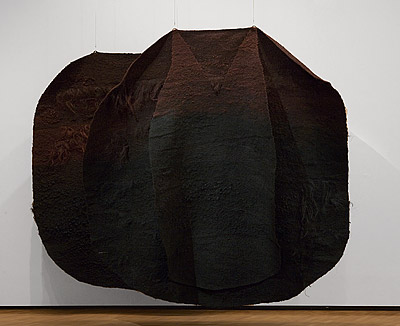Magdalena
ABAKANOWICZ
Poland
1930
Abakan Brunne
c.1970
dyed sisal
signed M.ABAKANOWICZ in paint on black suede leather strip sewn to lower left front of 43061.1
309.0 (h)
x 306.0 (w)
x 46.0 (d)
cm
National Gallery of Australia, Canberra
NGA 1976.1318.A-B
Magdalena Abakanowicz’s work came to international attention through the emotional intensity of its engagement with fibre and textiles. Her ‘Abakans’—a generic title for a series of interrelated works described by the artist as ‘textile situations’—are woven structures in which shaped tapestry elements are assembled to form enveloping installations. Some of the first Abakans, titled Composition of white forms, were exhibited in 1962 at the 1st International Biennial of Tapestry in Lausanne, Switzerland. They created a sensation, not only for their monumental scale, but for Abakanowicz’s aggressive departure from the craft traditions and pictorial conventions of tapestry weaving.
Abakanowicz studied painting and drawing at Warsaw’s Academy of Fine Arts, part of a new wave of art in post-World War II Poland. By 1958 her abstract relief works—incorporating three-dimensional elements suggesting forms from nature—were already showing the monumental scale for which she is best known. Eschewing the refined fibres associated with tapestry, Abakanowicz used coarse, readily available materials such as sisal and horsehair to build physical and visual density and light-reflecting texture into her works. A dark dye palette of browns, blacks and reds—evoking skins, bark and enveloping and decaying organic growth—further removed these textiles from a traditional decorative context. All these elements are visible in Abakan Brunne.
While tapestry had been characterised by its massive scale and romantic and heroic imagery, Abakanowicz’s interpretation involves the viewer in a direct and visceral way with the form and structure of the textile itself. Traditional techniques of Gobelin tapestry—such as weft face and the vertical slits between areas of pattern and colour—are still evident in her works, but on a much larger scale these devices become gestural and sculptural, giving the dwarfed viewer a sense of intense intimacy with the work. Joined elements become scar-like, and openings suggest wounds; untrimmed weft fringes and changes in yarn scale suggest growth and age; while the odour of dyed sisal assaults the senses. By freeing the textile from its conventional placement on the wall, hanging it in space and adding oppositional elements and apertures to the flat weave structure, Abakanowicz asserts the three-dimensionality that has been at the core of tapestry’s visual language.
Abakanowicz’s work revolutionised weaving and fibre art during the 1960s, particularly in Eastern Europe and the United States of America. It had a similar impact in Australia where, in workshops to coincide with her 1976 exhibition,[1] she introduced many artists to the possibilities inherent in using fibre and textile materials as media for large-scale sculpture. Later Abakanowicz broadened her range of materials, incorporating ready-made textiles such as burlap and rope, as well as wood elements, with the Abakans. Some works were reconfigured to suit particular spaces and all were orchestrated to animate the entire volume of each exhibition space.
In other series from the mid-1970s Abakanowicz also began to incorporate elements of the human form as stiffened fibrous structures of emaciated figures and heads, and stuffed cocoon-like like objects, some of which were also realised in bronze and ceramic. The intense physicality of her later large-scale outdoor sculptures in stone and wood was a move away from the perceived impermanence and vulnerability of the soft works in fibre. However, their harshness also reinforces the fragility of the human condition, a concern that has shaped Abakanowicz’s structures, whether soft and handmade, or hard and unyielding.
Robert Bell
Senior Curator
Decorative Arts and Design
National Gallery of Australia, Canberra
[1] Sponsored by the Crafts Board of the Australia Council and the Polish People’s Republic

